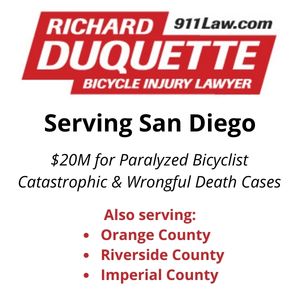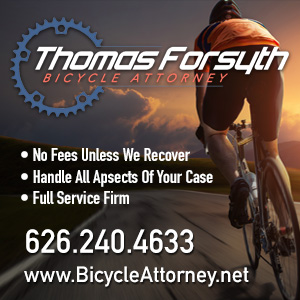*With apologies to The Killer
A lot of big events coming up in the L.A. bike world over the next few weeks. So mark your calendar and make your plans.
………
First up, simply because it is first up, is Bike Week at the Barnsdall Municipal Gallery, as Jennifer Moran, Brian Janeczko, Enci Box and Aurisha Smolarski present the collaborative project, In the Living Room of LA’s Bicycle Culture, through Sunday.
………
Thanks to Zach Behrens of LAist for the reminder about this Saturday’s Ride to Arrest Cancer bike ride and wellness fair sponsored by the LAPD.
This is your chance to roll with the men and women in blue on routes of 15, 25 and 50 miles, starting at the Valley Traffic Division at the Plant in Panorama City and visiting various police stations throughout the Valley. Preregistration cost is just $25 for adults ($30 day of the ride) and $15 for kids under 12, and includes BBQ, a T-Shirt and official police escort.
The ride benefits the Los Angeles Police Cancer Support Group, which assists “members of the law enforcement community who are living with cancer, cancer survivors, family members, friends, or caregivers.”
I’m usually not a fan of mass charity rides, but this one sounds like a lot of fun. And after watching too many friends and family fight cancer, I can’t think of a more deserving cause.
………
Also on Saturday, the 2nd Annual ArtCycle, billed as a conjunction of art, music and bicycles. The free event takes place from 2 pm to 10 pm at the junction of Santa Monica and Madison in East Hollywood. Better yet, Santa Monica will be shut down to vehicle traffic in sort of a mini-CicLAvia, so bring your bike and check it out.
………
Next week marks the return of the new and improved Bike Summit — now expanded to include a broader view of non-motorized traffic and renamed the LA StreetSummit 2010, Biking, Walking & Beyond.
This was by far the most informative — and yes, fun — event I attended last year, whether on a panel or part of the audience. And a rare opportunity to connect with a broad cross-section of cyclists of every type, while listening to and meeting some of the leading authorities on a wide-range of transportation subjects.
It begins at 7:30 pm on Thursday the 18th with a keynote address at Occidental College’s Keck Theater by Janette Sadik-Khan New York City’s now legendary Commissioner of Transportation — the woman responsible for tripling the amount of bikeways in just 3 years, in one of the world’s most crowded, built-out and bike-unfriendly cities on the planet.
And like the song says, if they can do it there, they can do it anywhere. So hopefully every employee of LADOT and Metro, and every elected official in the city will be sitting in the audience taking notes right next to me.
Because this is one talk I won’t miss.
………
On Saturday, March 20, Street Summit takes place from 10 am to 5 pm at Downtown’s LA Trade Tech College.
The morning session starts with featured speakers including Carl Anthony, the founder of Urban Habitat; Charlie Gandy, Mobility Coordinator for the City of Long Beach — which is rapidly on it’s way to becoming one of the nation’s most bike-friendly communities — and Lydia Avila of the East LA Community Corporation (ELACC).
That’s followed by a series of workshops in the afternoon, with sessions starting at 1 pm, 2 pm and 3 pm, ranging from discussions on CicLAvia and the bike plan to diversifying the bike community and what the hell is happening in Long Beach. Along with about 26 others to suit virtually every taste and interest.
And yes, I’ll be attending.
In fact, I’ll be hosting a 1 pm workshop on bikes and politics with Aurisha Smolarski of the LACBC, Marcel Porras, Transportation Director for L.A.’s 13th Council District, and David Vahedi, a recent candidate for L.A.’s 5th Council District. More information on that next week.
And did I mention it’s all free? Even the lunch (insert “there’s no free lunch punchline” here).
But only if you pre-register by March 15.
………
Also on the 20th — and also courtesy of LAist’s Zach Behrens — comes word of the Hit the Trail rides in Santa Clarita.
The City of Santa Clarita invites residents to join Mayor Laurene Weste and the City Council for Hit the Trail on Saturday March 20, 2010. The 3rd annual community bike ride will kick off promptly at 10 a.m. from three convenient starting points across the City and culminate with an exciting Bridgeport Park Rally.
Hit the Trail offers the unique opportunity for residents of all ages to join in a leisurely community bike ride along the City’s extensive trail system. There is no cost to participate- just arrive at one of these three convenient starting locations by 10 a.m. for a fun-filled ride to Bridgeport Park:
Route 1 (6.1 miles) – Valencia High School (San Francisquito Creek Trail)
Route 2 (4.3 miles) – Placerita Junior High School (South Fork Trail)
Route 3 (7.1 miles) – Camp Plenty Trailhead at Camp Plenty Road and Soledad Canyon Road (Chuck Pontius Commuter Rail Trail)
………
County Supervisor Zev Yaroslavsky reminds cyclists about Metro’s upcoming bike and pedestrian count on the Valley’s Orange Line Bikeway March 24 and 27. To sweeten the deal, they’re throwing in free pizza and T-shirts at the training/orientation session on the 22nd.
Free food and T-shirts? Damn! They’ve discovered our Achilles heel.
………
Next month, Streetsblog holds it’s first fundraiser at L.A.’s Eco-Village on April 9th, honoring the winners of this year’s Streetsie Awards, including the L.ACBC’S City of Lights program, the Eco-Village, ArtCycle and a certain bike blogger you may be acquainted with.
………
And a little further in the future —
May 2nd, you have a rare chance to ride the Vincent Thomas bridge across the L.A. Harbor — and help fight diabetes — with the 2010 Tour de Cure Ship-To-Shore Bike Ride.
The following month, help support the city’s leading bicycle advocacy group with what is probably the city’s most popular yearly bike ride, the 10th Annual Los Angeles River Ride presented by the LACBC on Sunday, June 6th.
………
In case you were wondering where I was all afternoon…
The LACBC reports on today’s meeting of the LAPD Bike Task Force, including the release of a document signed by Assistant Chief Paysinger marking the first steps in the department’s new bike training program.
………
And now, a long, long list o’links.
Follow up the Street Summit with the Street/Bike Summit After Party, just a short currently feasible ride to the north. Take a look at the city’s first graphic street maps of bike collision data, with more promised soon. Will confronts a jerk driver who nearly turned him into roadkill. An upcoming UCLA Rosenfeld Forum on bold solutions for L.A.’s traffic problems evidently neglects to consider cycling. If L.A. really can get sharrows on the street by summer, it will only have taken 2 years; LADOT Bike Coordinator Michelle Mowery doesn’t think it’s possible — and if anyone cares, I vote for putting them on Abbot Kinney; low-traffic streets like Westwood’s Westholme Ave. don’t need them.
A Whittier cyclist dies over 2-1/2 years after the collision that killed him. Pro tips to help you master Google’s new bike maps; or try a video introduction, if you prefer. Refuting the myths that motorist use to fight cycling. Is San Francisco’s Muni driving more people onto bikes?
Dave Moulton asks what’s the problem with banning cell use while riding? A Connecticut cyclist sounds off about lazy drivers who put their dogs at risk. Colorado’s broken-ribbed cycling governor is officially back on the job. A teenager in Colorado is found guilty for shooting at a group of bike riders; the victim spit the bullet out of his mouth. Does a revival of the cruiser mean bikes are regaining acceptance as transportation? DC’s mayor gets a new Colnago EPS worth about $11,990 more than the limit he’s allowed to accept. Found outside a Boston-area Trader Joes, a handbuilt bike made of bamboo and gaffers tape. Very cool black and white photos of a slowly defrosting Windy city.
Contador throws down the Gauntlet for this year’s Le Tour by destroying the field in the 4th Stage of Paris-Nice. Marissa Tomei rides a bike through the heart of Italy. After the carnage leading up to South Africa’s Cape Argus bike tour, a rider argues that car keys and common sense seem to be mutually exclusive. A biking Vancouver city official is injured in a collision the day before he was due to open a bike lane he’d fought for. It’s not the Idaho stop, but London considers allowing cyclists to turn left (equivalent to our right) on a red; meanwhile, London’s mayor is urged to ban large trucks from key bike routes. Tesco unveils its first in-store bike shops; imagine a bike department between Produce and Dairy at your neighborhood Vons. Test riding the women’s spring-suspension model of the classic Brooks saddle. Jersey — think old, not New — narrowly avoids a mandatory helmet law for everyone, while passing it for riders under 18. A call to license all cyclists over 16 on the Isle of Man. A perfect cycle chic day on the streets of Copenhagen, brought to you by Biomega with an assist from Flying Pigeon.
Finally, it looks like Downtown’s Angels Flight funicular may finally reopen, nine years after a tragic accident killed an 89-year old man; I wonder if they’ll limit it to two bikes per car.
Like this:
Like Loading...
 Stephen Box calls for eliminating LADOT. The LACBC makes final results from last year’s bike count available for download; Damien uses the figures to deftly refute common misconceptions about L.A. bicycling. Gary reports on the meeting to improve a major intersection in Santa Monica, and says more cyclists need to turn out if they want things to get better. The LAPD reports on the recent Downtown sting that resulted in the arrest of an accused bike thief. Flying Pigeon’s next Get Sum Dim Ride takes place this Sunday. Yet another reason to ride — we’re #1 in time wasted due to traffic congestion. Who were those racers in red who dropped you last weekend? The Pedouins make it to Monterrey. Bob Mionske explains how to protect yourself when shipping your bike. A driver in the most dangerous state for cyclists warns that riders need to look out for bigger vehicles; a Wisconsin writer says traffic laws exist to protect, not inconvenience, us. An avid cyclist says get off your bike and walk it through the crosswalk. An interstate highway for bikes could be coming to the Midwest. New photos of a British cyclist missing in Virginia. Lance will ride Saturday’s Milan-San Remo race. Alejandro Valverde faces a two-year ban stemming from Spain’s Operacion Puerto investigation. Being blind doesn’t stop Andrea Bocelli from riding a bike. A Brit rider takes off on a two month tour, and returns three years and 37,000 miles later. The Pope could chase the finish of this year’s Tour of Britain from Central London. Edinburgh considers mandatory bike training in primary schools. Toronto shoppers prefer bike lanes. Women’s wear that goes from bike to office — “Hideous and unflattering.”
Stephen Box calls for eliminating LADOT. The LACBC makes final results from last year’s bike count available for download; Damien uses the figures to deftly refute common misconceptions about L.A. bicycling. Gary reports on the meeting to improve a major intersection in Santa Monica, and says more cyclists need to turn out if they want things to get better. The LAPD reports on the recent Downtown sting that resulted in the arrest of an accused bike thief. Flying Pigeon’s next Get Sum Dim Ride takes place this Sunday. Yet another reason to ride — we’re #1 in time wasted due to traffic congestion. Who were those racers in red who dropped you last weekend? The Pedouins make it to Monterrey. Bob Mionske explains how to protect yourself when shipping your bike. A driver in the most dangerous state for cyclists warns that riders need to look out for bigger vehicles; a Wisconsin writer says traffic laws exist to protect, not inconvenience, us. An avid cyclist says get off your bike and walk it through the crosswalk. An interstate highway for bikes could be coming to the Midwest. New photos of a British cyclist missing in Virginia. Lance will ride Saturday’s Milan-San Remo race. Alejandro Valverde faces a two-year ban stemming from Spain’s Operacion Puerto investigation. Being blind doesn’t stop Andrea Bocelli from riding a bike. A Brit rider takes off on a two month tour, and returns three years and 37,000 miles later. The Pope could chase the finish of this year’s Tour of Britain from Central London. Edinburgh considers mandatory bike training in primary schools. Toronto shoppers prefer bike lanes. Women’s wear that goes from bike to office — “Hideous and unflattering.”







